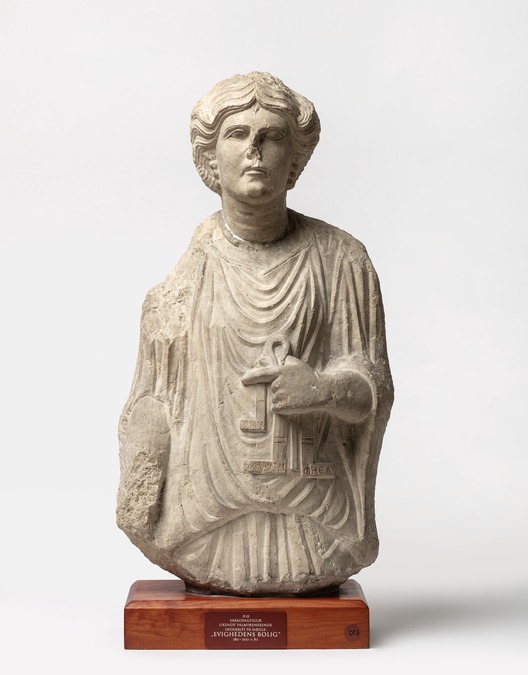Woman from a Palmyrene sarcophagus, standing sarcophagus lid
Summary
The portrait of a woman derives from a sarcophagus, found in an unknorn Palmyrene tomb. The surface of the portrait is slightly weathered. Most of her nose is missing, along with the right shoulder, part of the right forearm and the right hand. Three separate inscriptions are sitiuated on the three keys held by the woman. They all carry traces of red pigment.
The woman is wearing a tunic and she is adorned with jewellery. She is holding three keys in her left hand.
Description of object
The relief depicts a standing female figure, depicted frontally. The woman depicted, unidentified here, was probably a part of a large sarcophagus, now detached just below the waist. The surface of the portrait is slightly weathered, and damaged in some places. Most of her nose is missing, along with the right shoulder, part of the right forearm and the right hand. Three separate inscriptions are situated on the three keys held by the woman, all of which carry traces of red pigment.
Her head is elevated upwards in a glancing gaze, with long, piled-up hair gathered at the neck. The coiffured, wavy hair of the sarcophagus has a central parting, and a small lock of hair is depicted in the middle of her forehead. The hair is indicated by wavy ridges and grooves.
The unnamed woman’s face is depicted as fleshy and square in shape. Her forehead is flattened and her eyebrows are indicated by wide ridges, with incisions and traces of a dark pigment marking them out further, although they are rather thin. Her eyelids are heavy, almond-shaped, and her eyes are large. The iris is indicated by an incised circle, while the pupil is not rendered. Her earlobes are visible, and she wears earrings with three round juxtaposed beads suspended from the lobes by a thin element, possibly from the hook. Her nose is straight and wide, and the mouth is small with full, but not plump lips. Her chin is pointed, and she has what appears to be a double chin. Her neck is long and wide with two curved grooves. She wears a plain, thick hoop necklace at the base of her neck. The woman is wearing a short-sleeved tunic with a wide v-shaped neckline. The folds of the tunic are indicated by ridges and are further underlined by a belt, creating a big fold just below the stomach of the woman. She is also wearing a himation and a fold is visible falling from the left shoulder. Both arms are under proportioned. The right arm is held down the side, while the left arm is flexed and held in front of the torso. Three keys are held with her left hand. The thumb and index finger are extended, while holding on to a fold of garment. The rest of the fingers are flexed. She is wearing earrings consisting of three beads placed vertically on a row. A plain necklace, with a large circular pendant, is situated close to her neck.
Inscription: (key to the left) ΛΝΥ The meaning of these Greek letters are unknown. It has been suggested to be read as the date 451, that is 139/140 C.E., however, this year is not consistent with the dating of the object, which is a century later.
(Key in the middle) BT ʽLMʾ House of eternity (Key to the right) ΘΗΕΛΙChoice of methods
Visual examination
- Macroscopic
Bibliography
Ingholt Archive
D. Simonsen (1899), Skulpturer og Indskrifter fra Palmyra, København, 37, no. 43.
P.F.S Poulsen (1921), De palmyrenske skulpturer, Tidsskrift for Konstvetenskab, 87-88, fig. 11.
J.-B. Chabot (1922), Choix d’inscriptions de Palmyre, Paris, 120, no. 34, pl. XXX,3.
H. Ingholt (1928), Studier over Palmyrensk Skulptur, København, 143, PS 458.
S. Ronzevalle (1934), Sîma – Athéna – Némésis, Orientali, 3, 127, pl. VI,1.
D. Mackay (1949), The Jewellery of Palmyra and its Significance, Iraq XI, 167, pl. LII,1
H.J.W. Drivjers (1982), After Life and Symbolism in Palmyrene Religion, in B. Ugo & M.J. Vermaseren (eds.), La soteriologia dei culti orientali nell’impero Romano, Atti del Colloquio Internazionale su la Soteriologia dei culti orientali nell’imperio Romano, Roma, 24-28 Settembre 1979, 711-712, 720.
K. Parlasca (1988), Ikonographische Probleme palmyrenischer Grabreliefs, Damaszener Mitteilunge 3, 217-218, taf. 46d.
F.O. Hvidberg-Hansen & G. Ploug (1993), Palmyra Samlingen, Ny Carlsberg Glyptotek, København, 135-136, no. 89.
G. Ploug (1995), Catalogue of Palmyrene Sculptures, Ny Carlsberg Glyptotek, Copenhagen, 216-218.
F.O. Hvidberg-Hansen (1998), The Palmyrene Inscriptions. Ny Carlsberg Glyptotek, Copenhagen, 77-78, no. 89.
J.B. Yon (2012), Inscriptions grecques et latines de la Syrie, Palmyre, tome XVII, Fascicule 1, Beirut, 417-418, no. 560.
Sokołowski, L. 2014, Portraying the Literacy of Palmyra: The Evidence of Funerary Sculpture and its Interpretation, Ètudes et travaux 27, 281, 399, fig. 14
S. Krag (2015), The secrets of the funerary buildings in Palmyra during the Roman period, in Mortensen, E. and Saxkjær, S.G. (eds.), Revealing and concealing in Antiquity. Textual and Archaeological Approaches to Secrecy, Aarhus, 110-111, fig. 5.
S. Krag (2018), Funerary Representations of Palmyrene Women. From the First Century BC to the Third Century AD, Studies in Classical Archaeology 3, Turnhout, 15-16, 49, 105, 381, cat. no. 804.
- IN 1065
- Portrait
- c. 230-250 C.E.
- Roman Imperial
- Limestone
- Acquired by Løytved in Syria. Original grave context unknown.
- Overall, H: 67.5 cm.; W: 35 cm.; D: 25 cm. Head, H: 17 cm.; W: 16.5 cm.; D: 16.5cm.




